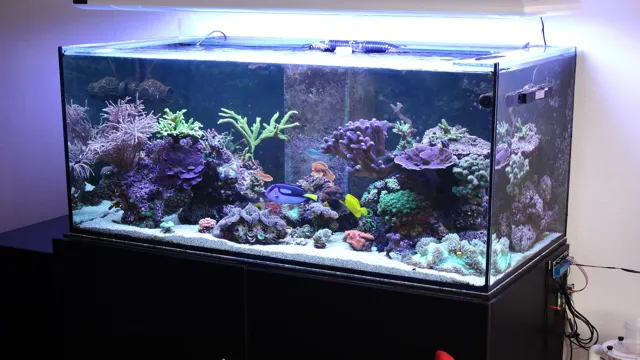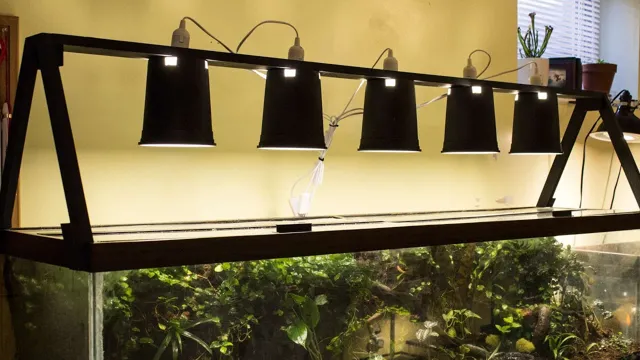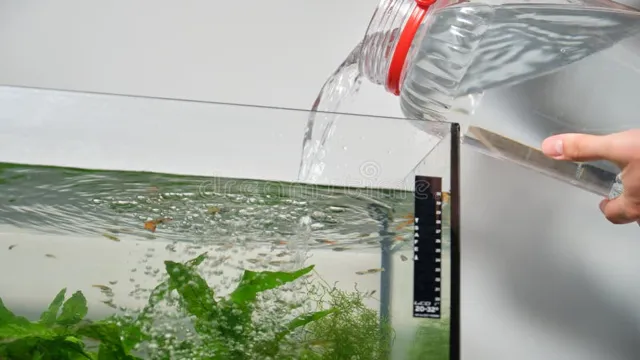Do you have an old aquarium that’s just collecting dust? Maybe you’re not into keeping fish anymore, or you’ve upgraded to a larger tank. If you’re looking for a fun DIY project that will turn your old aquarium into a new display case, you’ve come to the right place. Transforming your aquarium into a display case gives it a new purpose and a fresh look that can add character to your home.
With some simple steps and a few creative ideas, you can turn your aquarium into a unique display case that showcases your favorite items or collections. Whether you’re into vintage toys, rare crystals, or quirky knick-knacks, your aquarium can be converted into a creative and functional display case. By repurposing your old aquarium, you’re not only giving it a new life, but you’re also doing your part for the environment by reducing waste.
So why not grab your tools and get started on this exciting DIY project today?
Evaluate Your Aquarium
If you’re looking for a creative way to repurpose an old aquarium, why not turn it into a stunning display case? With just a few simple steps, you can transform your fish tank into a beautiful piece of furniture that showcases your favorite items. First, clean out the tank thoroughly and remove any leftover debris. Next, choose your items to display and arrange them in an aesthetically pleasing way.
You can use items like shells, marbles, or other small decorative pieces to add texture and depth. Finally, add lighting to highlight your display and create a beautiful, eye-catching piece. By repurposing your old aquarium, you can create a unique and personalized piece of furniture that adds character and style to your home.
So get creative and start transforming your old aquarium into a stunning display case today!
Check the Size and Shape of the Aquarium
When evaluating your aquarium, it’s important to start by checking its size and shape. These factors can greatly impact the health and happiness of your fish and other aquatic creatures. A tank that is too small may not provide enough space for your fish to swim and play, leading to stress and even illness.
On the other hand, a tank that is too large may be difficult to maintain and can lead to problems with water quality. Additionally, the shape of the tank can impact the behavior of your fish. For instance, tall, narrow tanks may not provide enough surface area for proper gas exchange, while long, shallow tanks can promote more natural swimming behaviors for certain species.
Overall, taking the time to evaluate your aquarium’s size and shape can help ensure that your aquatic pets thrive in their aquatic environment.

Ensure that the Aquarium is Clean
Cleaning your aquarium is crucial to ensure the health and wellbeing of your fish and aquatic plants. First, you need to evaluate your aquarium and assess the level of cleaning it requires. Check the water parameters, such as pH level, ammonia, nitrite, and nitrate levels, to ensure they are within the acceptable ranges.
You should also inspect the glass and decorations for any signs of algae or debris buildup and clean them accordingly. Additionally, check the filter and replace or clean the filter media if necessary. Overfeeding your fish can also contribute to dirty water, so make sure you’re not doing that.
Regular checking and maintenance of your aquarium will prevent the accumulation of harmful bacteria and keep your aquatic environment healthy and clean. By keeping your aquarium clean, you can also prevent unwanted smells and improve its overall appearance. Don’t forget to use a reliable water conditioner, aquarium salt, and other necessary products to keep the water safe for your fish.
With careful attention and maintenance, your aquarium can be a beautiful and thriving aquatic ecosystem for years to come.
Decide the Type of Display Case
If you’re thinking about making a display case from an aquarium, the first thing you need to decide is the type of display case you’re looking for. Depending on your needs and preferences, you may choose from a range of options, including single or multiple shelves, open or closed cases, and standing or wall-mounted displays. You’ll also need to consider the size and shape of your aquarium, as well as the items you plan to display.
For example, if you’re planning to display small items, you may want to opt for multiple shelves or a closed case to keep them safe and secure. On the other hand, if you have larger items or want to display a collection of items together, an open case or a standing display may be more suitable. Whatever your needs, taking the time to consider the type of display case you want will help you create a stunning aquarium display that showcases your treasures in style.
Choose between a Shelf or a Cabinet
When it comes to displaying your prized possessions, there are a few factors to consider before choosing between a shelf or a cabinet. Firstly, think about the size of the items you want to display. If you have larger items such as sculptures or vases, a cabinet may be a better option as it offers more protection from the elements and potential damage.
On the other hand, if you have smaller items such as figurines or trinkets, a shelf may be more appropriate as it allows for easier viewing and accessibility. Additionally, consider the style of your space. If you have a more modern or minimalist aesthetic, a sleek cabinet with glass doors may fit in better.
However, if you prefer a more eclectic or vintage look, a rustic wooden shelf may be the way to go. Ultimately, it’s important to choose a type of display case that not only showcases your items effectively but also complements the overall decor of your space.
Determine the Number of Shelves or Cabinets Needed
When deciding on a display case for your valuable items, it’s important to determine the number of shelves or cabinets needed. This will depend on the size and quantity of items you plan to display. If you have a large collection that you want to showcase, then a cabinet with multiple shelves may be the best option for you.
On the other hand, if you have smaller items that require close inspection, then a display case with fewer shelves and more space between them may be more suitable. When it comes to deciding the type of display case, there are various options to choose from, such as wall-mounted cases, tabletop cases, or freestanding floor cases. Each type of case offers unique features and benefits, so it’s important to consider your specific needs and preferences when making your selection. (See Also: How to Keep an Octopus in an Aquarium: Tips for a Happy and Healthy Cephalopod)
Ultimately, the key is to choose a display case that not only properly stores and showcases your items, but also complements the overall aesthetic of your space.
Gathering Materials
If you’re looking for a unique way to display your collectibles or memorabilia, turning an old aquarium into a display case can be a great idea. But before you get started, you’ll need to gather the materials you’ll need. First and foremost, you’ll need an old aquarium that’s just the right size for your items.
You’ll also need a glass cutter, a silicone aquarium sealant, and some lumber that will fit around the edges of your aquarium. Additionally, you can add some LED lights or background paper to give your display case some extra flair. Once you have all of your materials together, you’ll be ready to start transforming your old aquarium into an eye-catching display case that’s sure to grab attention.
So why not dig out that old aquarium from the garage and get started on your next DIY project?
Glass or Acrylic Sheets
When it comes to gathering materials for your DIY project, you may be debating between using glass or acrylic sheets. Both materials have their pros and cons, so it ultimately depends on what you’re looking to accomplish. Glass is a classic and timeless choice, but it can be heavy and prone to shattering.
On the other hand, acrylic sheets are lighter and more shatter-resistant, making them a great option for items that will undergo more wear and tear. Additionally, acrylic sheets can be bent and molded, allowing for more flexibility in your design. Ultimately, the decision between glass and acrylic comes down to what you’ll be using your creation for and what aesthetic you’re going for.
Keep in mind, however, that acrylic sheets may scratch more easily than glass and may require more maintenance over time.
Standoffs or Latches
When it comes to building a computer, every little detail counts. It may seem insignificant, but the method you use to secure your motherboard can greatly affect the stability and safety of your system. This is why choosing between standoffs or latches to secure your motherboard is crucial.
Standoffs are small brass or plastic pieces that screw into the case and elevate the motherboard above it. Latches are clips that snap onto the edges of the motherboard and keep it securely in place. Both options have their advantages and disadvantages, so it really comes down to personal preference and the specifications of your case and motherboard.
Whichever method you choose, make sure it’s the right fit for your setup. The last thing you want is a mishap due to a loose or unstable motherboard.
Silicone Sealant
When it comes to sealing a surface, silicone sealant is often the go-to solution. But before starting the sealing process, it is essential to gather all the necessary materials. Firstly, make sure to select the right type of silicone sealant that suits the specific project requirements.
Different sealants are available for a range of surfaces, such as glass, metal, or tiles. Secondly, ensure that the surface is clean, dry, and free from debris. It is advisable to use a degreaser or alcohol-based solution to remove any grease or oil residue.
Thirdly, have a sharp knife or scissors ready to cut the nozzle of the sealant tube. It is recommended to use a durable, reusable applicator or caulking gun to apply the sealant effectively. Lastly, have a damp cloth nearby to clean up any excess sealant that may ooze out during application.
By gathering all the necessary materials beforehand, the sealing process will be more efficient, and the end result will be a perfectly sealed surface.
Tools Needed
Gathering Materials: Before you can start any project, it’s important to gather all the necessary tools and materials. When it comes to DIY projects, having the right tools can make all the difference. For example, if you’re planning on painting a room, you’ll need to gather paint brushes, rollers, stir sticks, painter’s tape, and drop cloths.
If you’re planning on doing some woodworking, you’ll need a saw, sandpaper, clamps, and wood glue. It’s important to have all the tools and materials you need before you start, so you don’t have to stop in the middle of your project to run out and grab something you forgot. Plus, having everything organized and ready to go will make your work much easier and more enjoyable.
So, take some time before you start your next DIY project to gather all the necessary tools and materials. Trust me, you won’t regret it!
Building the Display Case
If you’re looking for a unique way to display your favorite items, consider making a display case out of an aquarium! It’s easy to do and will add a creative touch to any room. Start by thoroughly cleaning the aquarium and removing any unnecessary parts like filters or pumps. Then, measure and cut a piece of glass or acrylic to fit the top of the aquarium. (See Also: How to Get My Aquarium pH to 8.0: Expert Tips and Tricks)
This will act as the lid for your display case. Next, determine what type of backing you want to use for your display. You can use wallpaper or fabric to add a pop of color or keep it simple and use black or white poster board.
Now, it’s time to arrange your items on the backing. Play around with different arrangements until you find one that you love. Finally, carefully place the glass lid on top of the aquarium and secure it with clips or silicone adhesive.
Voila! You have a stunning display case that is sure to impress. Plus, using an aquarium adds a fun and unexpected touch to your decor. So go ahead and try it out!
Attaching Standoffs or Latches
Attaching standoffs or latches to your display case is an important step in building a sturdy and secure display. Standoffs are typically used to space the backing away from the case, giving it a more three-dimensional look. Latches, on the other hand, are used to secure the case and prevent it from accidentally opening.
When selecting standoffs and latches, it’s essential to consider the weight of your display and the material of your case. Stainless steel is a common choice for standoffs and latches because it is durable, easy to clean, and corrosion-resistant. When installing standoffs, it’s important to ensure they are level and lined up correctly, so your display looks professional and visually appealing.
Similarly, latches should be installed in a way that ensures they engage securely and smoothly, without being difficult to open or close. Ultimately, choosing the right standoffs and latches for your display case will help ensure that your items remain safe, secure, and well-presented.
Install the Glass or Acrylic Sheets
To finish building your display case, you will need to install the glass or acrylic sheets. This step is crucial because it will not only protect your items on display but also make them more visible. First, make sure that the sheets you have are the correct size and thickness for the frame.
Then, take extra care when handling the sheets to prevent any scratches or cracks. If you’re using glass, you may want to wear gloves to avoid leaving fingerprints. When you’re ready, place the sheets onto the frame and secure them in place with a screwdriver or a specialized adhesive.
Remember to seal any gaps or edges to make sure the case is airtight. Once the sheets are installed, you can finally step back and admire your hard work. Your display case is now ready to showcase your collection for all to see and enjoy!
Seal the Joints with Silicone
When it comes to building a display case, one of the crucial steps is sealing all the joints with silicone. This will ensure that your case is completely airtight, keeping your items safe and secure from dust, moisture, and other harmful elements. The process is relatively straightforward, but it does require some precision and attention to detail.
Start by cleaning all the joints thoroughly with a dry cloth or brush. Any debris or dirt should be cleared away before applying the silicone. Then, using a caulking gun, apply a steady stream of silicone along each joint.
Be sure to fill the entire gap without over-applying, as excess silicone can be difficult to remove. Once the silicone is applied, use your finger or a smoothing tool to spread it evenly along the joint. The goal here is to create a smooth and even layer of silicone that will provide a tight seal.
You can use a damp cloth to remove any excess silicone that may have been applied. Once the silicone is dry, you can apply a coat of paint or stain to match the rest of the case. This will not only give the case a finished look but will also help to protect the silicone from wear and tear.
Overall, sealing the joints with silicone is a crucial step in building a display case that will last for years to come. By taking the time to do it right, you’ll ensure that your items are well-protected and will be able to be enjoyed for years to come.
Finishing Touches
After setting up your aquarium display case, it’s time to add the finishing touches to make it a stunning focal point in your room. One way to add some character to your display case is to decorate the surrounding area. Consider adding some plants, rocks, or other natural elements that complement the theme of your aquarium.
Another way to add some personality is to add some LED lighting to highlight the underwater scenery. You can also add some small decorations, such as figurines or shells, to further enhance the display. Finally, make sure to clean the aquarium regularly and maintain the water quality to keep your display case looking its best.
With these final touches, your display case made from an aquarium will be a beautiful and captivating addition to your home décor.
Clean the Display Case
As you complete your display case setup and are ready to showcase your products, don’t forget the importance of a final touch: cleaning the display case. It’s easy to overlook, but the cleanliness of the case can make a big impact on the overall presentation of your products. A dusty or smudged case can distract from even the most eye-catching items.
Start by wiping down the exterior of the case with a clean microfiber cloth and then move on to cleaning the interior glass shelves and mirrors using a non-abrasive cleaner. Doing this will remove any smudges and fingerprints and give your products the perfect setting to shine in. It’s a simple step that can make a big difference in elevating the appeal of your products to customers. (See Also: How to Get Rid of Dead Spots in Aquarium: Tips and Tricks)
By taking the extra time to clean your display case, you show your attention to detail and care for your merchandise, which will ultimately impress your customers.
Choose and Arrange Items for Display
When it comes to displaying items, choosing and arranging them is crucial. The key is to create a visually appealing display that catches the eye and draws customers in. One effective way to do this is by grouping similar items together and arranging them in an aesthetically pleasing manner.
You can also use props, backdrops, or lighting to enhance the overall display and make it stand out. However, it’s important not to overcrowd the display as this can overwhelm customers and make it difficult for them to appreciate each item. Remember to keep it simple and let the items speak for themselves.
By taking the time to carefully choose and arrange your items, you can create a display that is both attractive and functional, providing customers with an enjoyable shopping experience.
Add Lighting for Maximum Visibility
Adding lighting to your space can make all the difference in achieving maximum visibility and safety. Whether you’re looking to add lighting to your home, office, or outdoor area, incorporating well-placed lights can be the finishing touch to complete your space. Not only can lighting elevate the aesthetic of your area, but it can also improve functionality by providing better visibility at night.
Utilizing brighter lights in areas with high foot traffic or where hazards may be present is essential for keeping yourself and others safe. Installing dimmer switches or using bulbs with adjustable brightness can also add versatility and adaptability to your lighting. Don’t underestimate the power of lighting; it can completely transform the look and feel of your space, while also ensuring that it is safe and functional for all who inhabit it.
Conclusion
By following these steps to repurpose an aquarium into a display case, you’ll have a clever and unique way to showcase your prized possessions. You’ll be able to create a delightful focal point that will draw the eye of your guests, allowing them to appreciate the beauty of your collection in a whole new light. So, instead of just having fish in a bowl, turn your old aquarium into something that will have jaws dropping, and allow everyone to see that sometimes, the treasure is the container itself.
“
FAQs
What materials do I need to make a display case from an aquarium?
You will need an aquarium, a glass cutter, silicone sealant, plywood, and a saw.
Can any size aquarium be used for a display case?
It is best to use a larger aquarium to create more display space, but any size aquarium can be used.
Can the aquarium be used as is or does it need to be modified?
The aquarium needs to be modified by removing the top and any accessories that may be attached.
Do I need to reinforce the tank in any way to hold the weight of the display items?
It is recommended to add additional support to the bottom of the tank with a piece of plywood cut to fit.
How do I cut the glass to create the display case?
Using a glass cutter, carefully score the glass where it needs to be cut, then apply pressure to break the glass along the score line.
What kind of sealant should I use to secure the glass panels?
Use a high-quality silicone sealant that is waterproof and safe for use with glass.
Can the display case be easily disassembled for cleaning or modification?
Yes, the display case can be taken apart by removing the silicone sealant and gently separating the glass panels.







